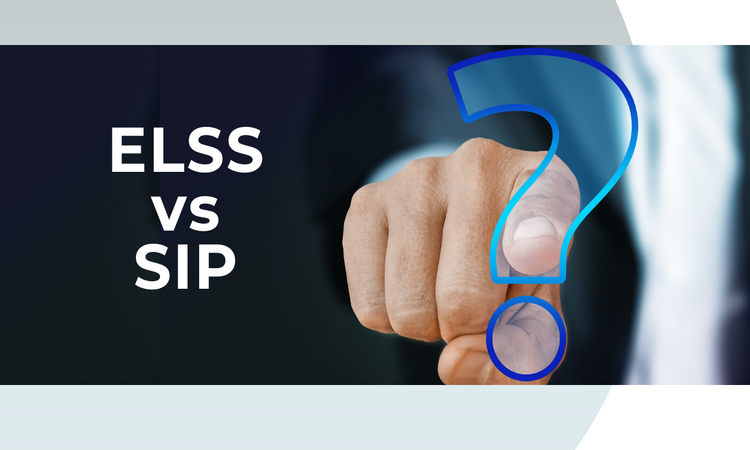
ELSS vs SIP is a comparison that runs on every investor’s mind at least till there is complete clarity about the fitment of these avenues in an individual’s financial plan.
ELSS or Equity Linked Savings Schemes and SIP or Systematic Investment Plan address the need of tax saving and wealth creation respectively and when the two are seen in conjunction, they can together meet both the needs of an investor efficiently.
We invest in ELSS funds as the investment in these funds qualifies for tax deduction u/s 80C of the Income Tax Act and this is the only option with the least lock in period. The lock in period in ELSS funds is 3 years and as these funds invest in equity markets, the return potential is higher too. This makes the ELSS funds an ideal avenue for tax saving as well as wealth creation.
Mode of investment in ELSS
One can choose to invest a lump sum amount in ELSS funds which will be a one-time investment done at any time during the financial year or one can also invest through the systematic investment route wherein a specified amount will be invested in the ELSS fund at regular intervals throughout the financial year.
While this choice is an individual one, it makes sense to split investment across the financial year rather than investing in one go or waiting for the last minute to carry out these tax saving investments in ELSS funds. This way one can manage cash flows more effectively and also reduce the risk element which is otherwise associated with equity investments that ELSS funds invest in.
Choosing the right ELSS fund
There are numerous ELSS funds available for investment and one must choose the right fund when investing in these. The choice should be a factor of the fund’s AUM, past performance & consistency, peer group comparison, fund’s expense ratio, portfolio holding, fund manager & his past experience & track record are few of the important criteria for one to consider.
ELSS Funds & Return
When looking to invest in an ELSS fund, it is best to consider returns in a span of 3 years and more. A look at returns in less than this period would not give an objective view to the investor.
Systematic Investment Plan
Systematic Investment Plan or SIP is not an investment but an approach under which an investor invests a pre specified amount at predefined intervals and this approach is one of the most sought after investment approaches for equity investments. While one may find it a little difficult to invest Rs.1 lac in one go, investing Rs.8k every month comes easy on the pocket and not only is the risk of equity investing averaged out by investing through the SIP route but also one is able to create a bigger investment corpus without straining one’s cash flows.
SIP in ELSS
SIP in ELSS serves two investment objectives simultaneously; that of tax saving as well as wealth creation. Ideally speaking, one can meet three objectives through a SIP in an ELSS fund which are tax saving, wealth creation as well as goal funding when these investments are linked to financial goals one has planned around one’s life.
ELSS vs SIP
ELSS vs SIP would not be the correct comparison barometer as both of these can aid in wealth creation and goal achievement in their own ways and rather than having a standalone view of these, it is better to look at these two together to get the best results as far as one’s financial objectives are concerned.
So, next time you plan a SIP investment, starting a SIP in a well performing ELSS fund could be an option to explore and benefit from.
ELSS or SIP have their own roles to play in an individual’s financial life when seen in a broader perspective and that is the correct way to look at them. A narrow view will prevent one from taking the right investment decisions and benefitting from ELSS as an efficient tax saving avenue and from SIP as a very noble concept aimed at wealth creation and goal funding.
People often ask
- Is SIP tax free?
- Is ELSS taxable after 3 years?
- Can I invest more than 1.5 lakhs in ELSS?
- Which SIP gives the highest return?
- Can ELSS be stopped?
No, SIP is not tax free. If a SIP is done in an ELSS fund, then there are tax benefits under section 80C of the Income tax act wherein investment upto Rs.1.5 lac in the ELSS funds are tax deductible. So, if a SIP of Rs.12.5k is done per month in an ELSS fund in a financial year, it stands tax deductible under the above mentioned section.
The ELSS investments are tax free. Earlier, they were tax exempt at all stages starting from investment, accumulation to withdrawal but now because of some amendments gains from these ELSS funds (also called as long term capital gains) above Rs.1 lakh are taxed at 10%.
Yes, one can invest as much amount in ELSS funds but the tax rebate is allowed only to the extent of Rs.1.5 lacs in a particular financial year.
SIP can be done in any mutual fund or even in any investment avenue. One cannot thus tell which SIP has given the highest return. Yes, if we are discussing fund categories like large cap funds or mid cap funds or value style funds, one can then make a comparison and share figures accordingly.
Yes, ELSS investments can be stopped at any point in time. They are withdrawn only after 3 years (minimum lock in period in ELSS funds) though.